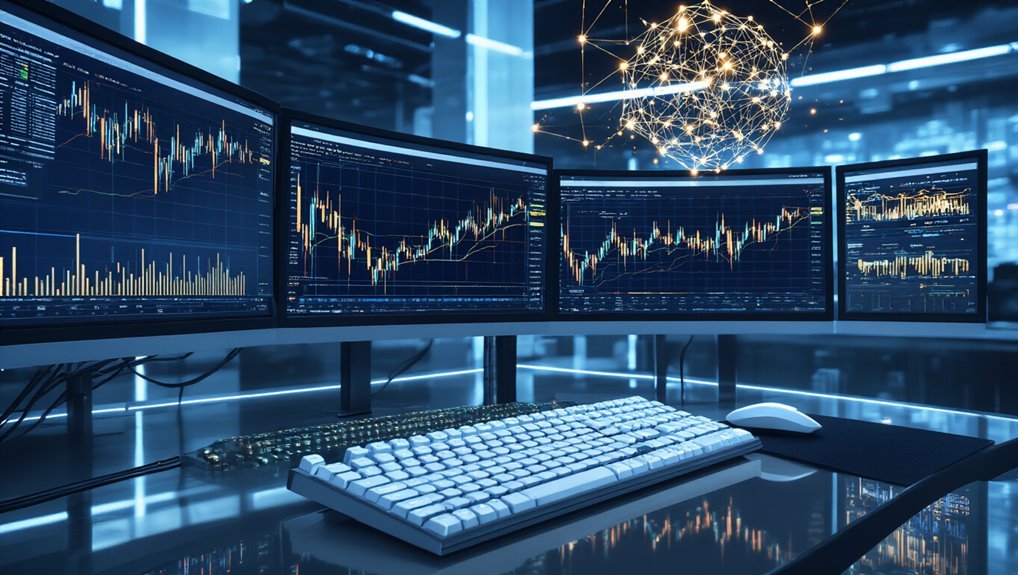Building high-performing AI trading strategies demands four critical foundations. First, clean, standardized data prevents model distortions and guarantees accuracy. Second, machine learning models—regression, classification, and deep learning—transform vast datasets into actionable predictions at lightning speed. Third, natural language processing analyzes market sentiment in real-time, classifying text data with high accuracy rates. Fourth, robust risk management frameworks prevent catastrophic losses through automated monitoring and Value-at-Risk calculations. These integrated components reveal superior market performance and efficiency gains that await exploration.
Essential Components for AI Trading Strategy Development

While many traders chase the latest AI buzzwords, the foundation of successful algorithmic trading rests on five critical components that separate profitable strategies from expensive experiments.
First comes data quality. Clean, standardized data from diverse sources prevents model distortions. Real-time feeds enable prompt market reactions. Historical data spanning various conditions supports robust backtesting.
Clean, standardized data from diverse sources forms the backbone of any profitable algorithmic trading strategy.
Strategy visualization follows. Flowcharts translate trading rules into programmable algorithms. Different markets demand customized rule sets. Clear time frames align execution with trading styles. Implementing Optimal Trade Entry techniques can help identify high-probability setups similar to institutional trading approaches.
Signal generation and execution systems identify opportunities through technical indicators or AI predictions. Automated execution reduces latency to milliseconds. Integration with broker APIs eliminates manual intervention.
Risk management prevents catastrophic losses through stop-losses and position sizing. Diversification mitigates exposure. Dynamic adjustments respond to volatility changes. The one-percent rule limits individual trade risk to preserve capital across multiple positions. Machine learning models can analyze complex pattern correlations that human traders might overlook when assessing risk factors.
Performance testing validates strategies through backtesting and forward testing. AI-powered bots adapt through ongoing learning. Systematic tracking with key performance indicators drives continuous refinement. Reinforcement learning agents adjust their trading approaches based on environmental feedback from market conditions.
Machine Learning Models and Predictive Analytics Integration
Modern trading algorithms rely on machine learning models that transform raw market data into actionable predictions. These systems process vast datasets—prices, volumes, order books, economic indicators—at superhuman speed.
Regression models predict price directions. Classification algorithms sort market patterns. Deep learning networks catch complex relationships that traditional methods miss. The real power comes from ensemble methods that combine multiple techniques, reducing bias and improving stability.
Reinforcement learning takes it further. These models learn through trial and error, adapting strategies via continuous feedback loops. Anomaly detection spots unusual price actions and liquidity imbalances—critical for short-term trades.
Real-time data feeds enable instant algorithmic responses. News sentiment gets fused with quantitative inputs to anticipate volatility spikes. Models retrain continuously, adapting to market shifts and evolving microstructure. ARIMA algorithms leverage historical price patterns to generate more accurate forecasts of future market values.
The payoff? Better timing. Enhanced precision. Confidence scores enable nuanced decision-making by providing probability assessments for each trade signal. Adaptive strategies that revise positions dynamically. Low-latency infrastructure ensures these AI-powered solutions execute trades with the speed necessary for competitive advantage. Automated decision-making eliminates emotional trading errors while processing thousands of variables beyond human capability.
Leveraging Natural Language Processing for Market Sentiment Analysis
Financial markets pulse with emotions. Fear. Greed. Uncertainty. These sentiments drive price movements, and Natural Language Processing captures them in real-time.
NLP techniques classify text into positive, negative, or neutral categories. Financial news, social media posts, earnings reports, and analyst commentary become data goldmines. Topic modeling identifies emerging themes. Named Entity Recognition extracts key companies and people for context.
The algorithms are sophisticated. Naive Bayes, Support Vector Machines, Recurrent Neural Networks. Deep learning models achieve 85% accuracy in sentiment detection. Lexicon-based methods score individual words, then aggregate for overall polarity. Hybrid approaches combine multiple techniques to address individual method limitations and enhance overall classification reliability.
Smart traders integrate sentiment scores into trading signals. They complement traditional technical analysis. Sentiment trends reveal market psychology phases. Better entry and exit timing follows. Proprietary models tailored for financial data enhance signal accuracy and provide actionable insights to improve decision-making.
But challenges exist. Financial jargon confuses models. Sarcasm remains problematic. Real-time processing demands serious computational power. Sentiment signals can be noisy. Continuous model retraining is essential to adapt to changing language patterns and ensure sustained accuracy.
The payoff? Enhanced strategy robustness when sentiment data combines with price and volume information. Traders often apply these insights to perpetual swaps and other crypto derivatives for more informed position-taking in volatile markets.
Risk Management Frameworks and Performance Optimization Techniques
Smart traders know sentiment analysis is just the beginning. Real success demands robust risk management frameworks and relentless performance optimization.
While sentiment analysis opens doors, seasoned traders understand that sustainable profits require disciplined risk frameworks and continuous performance refinement.
The NIST AI Risk Management Framework leads the charge here. It operates on four core functions: Map, Measure, Manage, and Govern. This isn’t theoretical stuff—it’s practical guidance for trustworthy AI deployment in trading operations.
Deep learning models now forecast Value-at-Risk with stunning accuracy. They update dynamically as markets shift. Meanwhile, reinforcement learning algorithms optimize strategies by learning from real-time feedback. No human can process multidimensional financial data at this scale.
AI systems monitor portfolios continuously. They detect abnormal trading patterns during off-hours. Flag elevated risks. Trigger early interventions. The framework was developed through an open and collaborative process, ensuring diverse stakeholder input into its design. Leading financial institutions now leverage ensemble methods like gradient boosting to enhance their risk assessment capabilities beyond traditional approaches. Similar to ICT methodology, these systems identify high-probability trades by analyzing institutional order flow patterns and market structure.
Advanced techniques shine brightest in performance optimization. Ensemble modeling combines multiple AI models, reducing forecast errors. Automated backtesting platforms enable rapid scenario testing with varying risk assumptions. Establishing monitoring practices ensures continuous adaptation to evolving market conditions and regulatory changes.
The result? Better risk-adjusted returns and enhanced market transparency.
Frequently Asked Questions
How Much Capital Is Required to Start Ai-Powered Trading?
Capital requirements for AI-powered trading vary dramatically by approach. Individual traders can start with $1,000 minimum for futures or test strategies with minimal amounts on platforms like RockFlow. Pattern day traders need $25,000 for forex compliance. However, serious AI trading operations require $30,000-$100,000+ covering technology infrastructure, software licenses, compliance costs, and adequate trading capital to absorb losses while algorithms prove themselves.
What Programming Languages Are Best for Developing AI Trading Systems?
Python dominates AI trading development. Its simplicity and extensive libraries like NumPy, pandas, and TensorFlow make it the top choice. C++ excels for high-frequency trading requiring millisecond latency. Java offers enterprise-level stability and scalability. Julia emerges as a promising high-performance option for numerical computing. R provides strong statistical analysis capabilities. Most developers start with Python, then integrate C++ for speed-critical components.
How Long Does It Take to Develop a Profitable AI Trading Strategy?
Developing a profitable AI trading strategy typically takes 6-12 months for sophisticated systems. Basic prototypes can emerge in 1-3 months. The timeline depends on several factors: data quality, computational resources, team expertise, and strategy complexity. Backtesting alone consumes weeks or months. Deep learning models extend development considerably. High-frequency strategies offer faster feedback loops but demand more computing power. Market conditions constantly shift, making development an ongoing process rather than a one-time effort.
What Are the Legal and Regulatory Considerations for AI Trading Deployment?
AI trading deployment faces complex regulatory hurdles across jurisdictions. The SEC, CFTC, and FINRA govern US markets. Europe enforces MiFID II and the incoming AI Act. Britain takes a principles-based approach under FCA oversight.
Firms must establish AI governance teams, guarantee model explainability, and maintain detailed records. Anti-manipulation controls are mandatory. Kill switches, continuous testing, and operational resilience requirements add layers of compliance complexity.
Can Individual Traders Compete With Institutional AI Trading Systems?
Individual traders face steep odds against institutional AI systems. Institutions command billion-dollar resources, deploy millisecond-speed algorithms, and maintain 24/7 operations across global markets. Retail traders work with limited capital and basic tools. However, gaps are narrowing. AI platforms increasingly serve individual traders. Human intuition still matters during unprecedented market events. The competition remains lopsided, but completely insurmountable? Not necessarily.
Conclusion
Building profitable AI trading strategies demands careful integration of machine learning models, sentiment analysis tools, and robust risk management systems. Success hinges on quality data feeds and rigorous backtesting. Natural language processing adds market context. But technology alone won’t guarantee profits. Traders must continuously monitor performance metrics. Adjust algorithms as market conditions shift. The most sophisticated AI system fails without proper risk controls and realistic expectations about market volatility.



